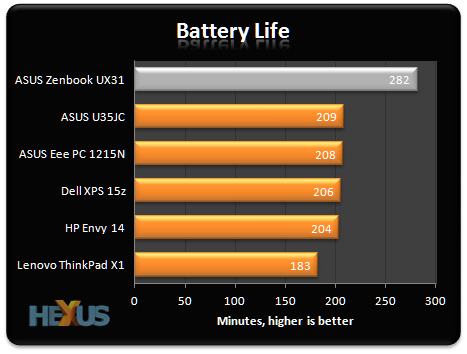Performance
Before we get on to benchmark results, here's a detailed specification of the ASUS Zenbook UX31 and the other laptops in our test.
Comparison Notebooks |
||||||
|---|---|---|---|---|---|---|
| Laptop | ASUS Eee PC 1215N | ASUS U35JC | ASUS Zenbook UX31 | Lenovo ThinkPad X1 | HP Envy 14-1050EA | Dell XPS 15z |
| Processor | Intel Atom D525 (1.80GHz, 1MB L2 cache, dual-core, 13W) | Intel Core i3-370M (2.40GHz, 3MB smart cache, dual-core, 35W) | Intel Core i7-2677M (1.80GHz, 4MB smart cache, dual-core, 17W) | Intel Core i5-2520M (2.50GHz, 3MB smart cache, dual-core, 35W) | Intel Core i5-450M (2.40GHz, 3MB smart cache, dual-core, 35W) | Intel Core i5-2410M (2.30GHz, 3MB smart cache, dual-core, 35W) |
| Memory | 2GB DDR3 | 4GB DDR3 | 4GB DDR3 | 4GB DDR3 | 4GB DDR3 | 4GB DDR3 |
| Graphics | Intel GMA 3150 + NVIDIA ION 2 | Intel HD Graphics + NVIDIA GeForce 310M 1GB | Intel HD 3000 | Intel HD 3000 | Intel HD Graphics + AMD Mobility Radeon HD 5650 1GB | Intel HD 3000 + NVIDIA GeForce GT 525M 1GB |
| Graphics driver | Intel 8.14.10.2117 + NVIDIA Verde 260.89 | Intel 8.15.10.2182 + NVIDIA Verde 258.96 | Intel 8.15.10.2476 | Intel 8.15.10.2321 | Intel 8.15.10.2182 + AMD Catalyst 10.9 | Intel 8.15.10.2321 + NVIDIA Verde 275.33 |
| Display | 12.1in - 1,366x768 | 13.3in - 1,366x768 | 13.3in - 1,600x900 | 13.3in - 1,366x768 | 14.5in - 1,366x768 | 15.6in - 1,366x768 |
| Battery | 6 cell, 56Whr | 8 cell, 84Whr | Polymer, 50Whr | 6 cell, 38.4Whr | 8 cell, 59Whr | 8 cell, 64Whr |
| Weight | 1,523g | 1,816g | 1,405g | 1,741g | 2,589g | 2,517g |
| Wireless | Broadcom WiFi (802.11bgn) and Bluetooth | Intel WiFi 5100 (802.11bgn) and Bluetooth | Atheros AR9485WB-EG (802.11bgn) and Bluetooth | Intel Centrino Ultimate-N 6300 (802.11bgn) and Bluetooth | Broadcom 43224AG (802.11bgn) and Bluetooth | Intel Centrino Advanced-N 6230 (802.11bgn) and Bluetooth |
| Disk drive(s) | Seagate Momentus 250GB HDD, 5,400RPM, 8MB cache | Seagate Momentus 320GB HDD, 5,400RPM, 8MB cache | ADATA XM11 120GB SSD | Hitachi Travelstar 320GB HDD, 7,200RPM, 16MB cache | Seagate Momentus 500GB HDD, 7,200RPM, 16MB cache | Seagate Momentus 500GB HDD, 7,200RPM, 16MB cache |
| Optical drive | None | None | None | None | DVD-RW | DVD-RW |
| Operating System | Microsoft Windows 7 Home Premium, 32-bit | Microsoft Windows 7 Home Premium, 64-bit | Microsoft Windows 7 Home Premium, 64-bit | Microsoft Windows 7 Professional, 64-bit | Microsoft Windows 7 Home Premium, 64-bit | Microsoft Windows 7 Home Premium, 64-bit |
Benchmarks |
||||||
| Geekbench | A cross-platform benchmark used to measure memory and processor performance. Run using high-performance mode. | |||||
| Cinebench | Using Cinebench's multi-CPU render, this cross-platform benchmark stresses as many cores as possible. Run using high-performance mode. | |||||
| 3DMark06 | A PC benchmark used to test the DirectX 9 performance of a system's graphics card. Run using high-performance mode. | |||||
| Power Consumption | Using balanced power settings, we record mains power draw whilst playing back a 720p movie trailer. | |||||
| Battery Test | In order to measure battery life, we run the notebook on balanced power settings and loop a 720p movie trailer, measuring the time taken to hibernate. | |||||
CPU and GPU performance

The ASUS Zenbook UX31 is the first system we've tested with an ultra-low-voltage Intel Sandy Bridge processor, but the lower core operating frequency doesn't dramatically impinge upon performance.
In Geekbench, the UX31 is only fractionally behind the full-fat Lenovo ThinkPad X1 and Dell XPS 15z. More importantly, the three Sandy Bridge systems are all well ahead of the previous-generation HP Envy 14, ASUS U35JC and Eee PC 1215N.

Looking specifically at CPU performance, Cinebench confirms that the low-power 17W Core i7-2677M is a potent performer, but it isn't the CPU that makes the UX31 feel lightning quick - it's the built-in SATA 6Gbps SSD.
During our tests, we found the ADATA drive capable of sequential read and write speeds of around 550MB/s and 510MB/s, respectively. The huge amount of speed available to the storage subsystem isn't depicted in the above graphs, but to give you an example we also ran the PCMark 7 benchmark, which takes storage performance into account.
In PCMark, the UX31 achieved an impressive score of 3,827, comfortably beating the ThinkPad X1's 2,122 and the Dell XPS 15z's 1,988. The SSD really makes that much of a difference, and it allows the UX31 to boot into Windows in under 20 seconds and resume from sleep in under three seconds.

The CPU and SSD combine to deliver near-instant system responsiveness, but the UX31 doesn't have GPU performance to match.
Using Intel's integrated HD 3000 graphics, the UX31 is able to playback high-def multimedia easily enough, but 3D gaming is largely out of reach. You might manage a couple of lightweight titles with low image quality, but demanding games are a no-go. When trying to play Just Cause 2 at 1,280x720 with the lowest possible quality settings, we achieved a stuttering 20.3 frames per second.
Power consumption and battery life

Here's where an ultra-low-voltage processor proves its worth. While looping a 720p movie clip, the UX31 consumes less power than any notebook in our line up. It's even less thirsty than the Intel Atom-powered Eee PC 1215N, which leverages NVIDIA ION graphics.

Take ultra-low power consumption and pair it with a 50Whr battery, and you get a good amount of system longevity.
In our battery rundown test - which entails looping a 720p movie clip using Windows Media Player - the UX31 managed to keep going for almost five hours. And that's using ASUS's balanced power profile, so you could get more by switching to a power-saving mode.









